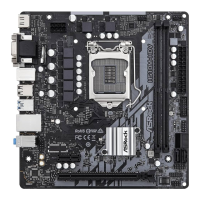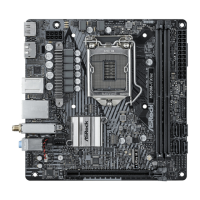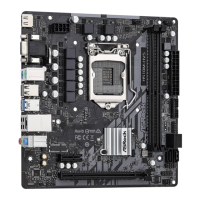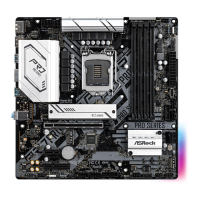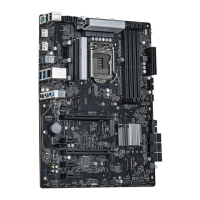Do you have a question about the ASROCK H510M-HDV and is the answer not in the manual?
Lists the items included in the motherboard package for user verification.
Details the technical specifications of the motherboard, including CPU, Memory, and Expansion Slots.
Illustrates and labels the physical components and connectors on the motherboard.
Describes the input/output ports available on the rear panel of the motherboard.
Step-by-step guide for safely installing the CPU into the motherboard socket.
Instructions for mounting the CPU cooling solution onto the motherboard.
Guide on correctly inserting RAM modules into the motherboard's DIMM slots.
Information on utilizing PCI Express slots for graphics cards and other expansion devices.
Explains the function and configuration of motherboard jumpers, such as Clear CMOS.
Details the purpose and connection of internal motherboard headers and connectors.
Guide on installing essential drivers from the support CD for optimal system performance.
Overview and usage instructions for the ASRock A-Tuning multi-purpose software suite.
Information on using the ASRock Live Update & APP Shop for software and utility management.
Explains how to access and navigate the UEFI SETUP UTILITY for system configuration.
Overview of the EZ Mode BIOS interface for quick system status checks and basic settings.
Introduction to the Advanced Mode for accessing detailed and comprehensive BIOS settings.
Describes the system overview and information displayed on the UEFI BIOS Main screen.
Details the settings available for overclocking and performance tuning in the BIOS.
Covers advanced system configurations including CPU, Chipset, Storage, ACPI, USB, and Trusted Computing.
Utility tools available in the UEFI BIOS, such as Instant Flash for BIOS updates.
Displays system hardware status, including CPU temperature, fan speeds, and voltages.
Settings for system passwords, secure boot, and platform trust technology.
Configures boot device priority, boot options, and CSM settings for system startup.
Options for saving changes, discarding them, or loading defaults before exiting the UEFI BIOS.
Lists the items included in the motherboard package for user verification.
Details the technical specifications of the motherboard, including CPU, Memory, and Expansion Slots.
Illustrates and labels the physical components and connectors on the motherboard.
Describes the input/output ports available on the rear panel of the motherboard.
Step-by-step guide for safely installing the CPU into the motherboard socket.
Instructions for mounting the CPU cooling solution onto the motherboard.
Guide on correctly inserting RAM modules into the motherboard's DIMM slots.
Information on utilizing PCI Express slots for graphics cards and other expansion devices.
Explains the function and configuration of motherboard jumpers, such as Clear CMOS.
Details the purpose and connection of internal motherboard headers and connectors.
Guide on installing essential drivers from the support CD for optimal system performance.
Overview and usage instructions for the ASRock A-Tuning multi-purpose software suite.
Information on using the ASRock Live Update & APP Shop for software and utility management.
Explains how to access and navigate the UEFI SETUP UTILITY for system configuration.
Overview of the EZ Mode BIOS interface for quick system status checks and basic settings.
Introduction to the Advanced Mode for accessing detailed and comprehensive BIOS settings.
Describes the system overview and information displayed on the UEFI BIOS Main screen.
Details the settings available for overclocking and performance tuning in the BIOS.
Covers advanced system configurations including CPU, Chipset, Storage, ACPI, USB, and Trusted Computing.
Utility tools available in the UEFI BIOS, such as Instant Flash for BIOS updates.
Displays system hardware status, including CPU temperature, fan speeds, and voltages.
Settings for system passwords, secure boot, and platform trust technology.
Configures boot device priority, boot options, and CSM settings for system startup.
Options for saving changes, discarding them, or loading defaults before exiting the UEFI BIOS.
| Processor socket | LGA 1200 (Socket H5) |
|---|---|
| Processor manufacturer | Intel |
| Compatible processor series | Intel Celeron, Intel Core i5, Intel Core i7, Intel Core i9, Intel Pentium |
| Non-ECC | Yes |
| Memory channels | Dual-channel |
| Memory slots type | DIMM |
| Number of memory slots | 2 |
| Supported memory types | DDR4-SDRAM |
| Maximum internal memory | 64 GB |
| Supported memory clock speeds | 2133, 2400, 2666, 2800, 2933, 3200 MHz |
| Number of HDDs supported | 4 |
| Supported storage drive interfaces | SATA III |
| Parallel processing technology support | - |
| USB 2.0 connectors | 1 |
| USB 3.2 Gen 2 (3.1 Gen 2) connectors | 0 |
| USB 2.0 ports quantity | USB 2.0 ports have a data transmission speed of 480 Mbps, and are backwards compatible with USB 1.1 ports. You can connect all kinds of peripheral devices to them. |
| Wi-Fi | No |
| LAN controller | Realtek RTL8111H |
| Ethernet interface type | Gigabit Ethernet |
| Component for | PC |
| Motherboard chipset | Intel H510 |
| Audio output channels | 7.1 channels |
| Motherboard form factor | micro ATX |
| Windows operating systems supported | Windows 10 x64 |
| BIOS type | EFI AMI |
| ACPI version | 6.0 |
| BIOS memory size | 128 Mbit |
| System Management BIOS (SMBIOS) version | 2.7 |
| Cables included | SATA |
| Harmonized System (HS) code | 84733020 |
| Weight | 1000 g |
| Depth | 188 mm |
|---|---|
| Width | 197 mm |
| Height | 70 mm |

